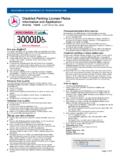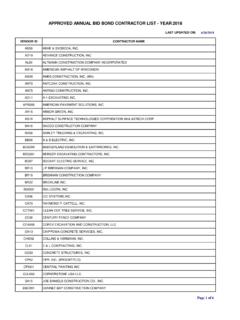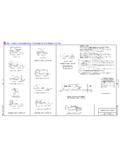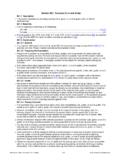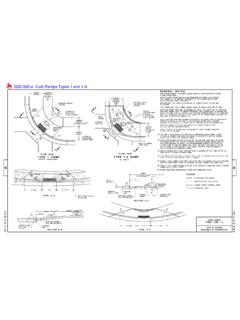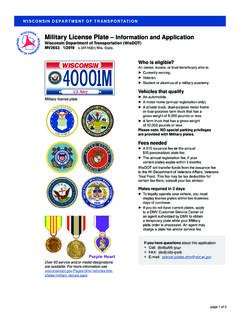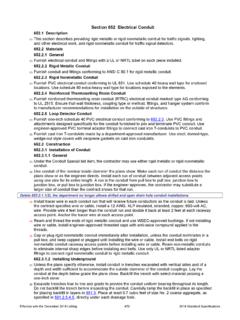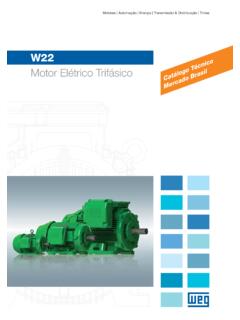Transcription of PART 6. TEMPORARY TRAFFIC CONTROL
1 2009 MUTCD Text part 6 - Page 1 of 163 December 2009 part 6. TEMPORARY TRAFFIC CONTROL CHAPTER 6A. GENERAL Section General CHAPTER 6B. FUNDAMENTAL PRINCIPLES Section Fundamental Principles of TEMPORARY TRAFFIC CONTROL CHAPTER 6C. TEMPORARY TRAFFIC CONTROL ELEMENTS Section TEMPORARY TRAFFIC CONTROL Plans Section TEMPORARY TRAFFIC CONTROL Zones Section Components of TEMPORARY TRAFFIC CONTROL Zones Section Advance Warning Area Section Transition Area Section Activity Area Section Termination Area Section Tapers Section Detours and Diversions Section One-Lane, Two-Way TRAFFIC CONTROL Section Flagger Method of One-Lane, Two-Way TRAFFIC CONTROL Section Flag Transfer Method of One-Lane, Two-Way TRAFFIC CONTROL Section Pilot Car Method of One-Lane, Two-Way TRAFFIC CONTROL Section TEMPORARY TRAFFIC CONTROL Signal Method of One-Lane.
2 Two-Way TRAFFIC CONTROL Section Stop or Yield CONTROL Method of One-Lane, Two-Way TRAFFIC CONTROL CHAPTER 6D. PEDESTRIAN AND WORKER SAFETY Section Pedestrian Considerations Section Accessibility Considerations Section Worker Safety Considerations CHAPTER 6E. FLAGGER CONTROL Section Qualifications for Flaggers Section High-Visibility Safety Apparel Section Hand-Signaling Devices Section Automated Flagger Assistance Devices Section STOP/SLOW Automated Flagger Assistance Devices Section Red/Yellow Lens Automated Flagger Assistance Devices Section Flagger Procedures Section Flagger Stations CHAPTER 6F. TEMPORARY TRAFFIC CONTROL ZONE DEVICES Section Types of Devices Section General Characteristics of Signs Section Sign Placement Section Sign Maintenance Section Regulatory Sign Authority Section Regulatory Sign Design Section Regulatory Sign Applications Section ROAD (STREET) CLOSED Sign (R11-2) Section Local TRAFFIC Only Signs (R11-3a, R11-4) Section Weight Limit Signs (R12-1, R12-2, R12-5) Section STAY IN LANE Sign (R4-9) Section Work Zone and Higher Fines Signs and Plaques Section PEDESTRIAN CROSSWALK Sign (R9-8) Section SIDEWALK CLOSED Signs (R9-9, R9-10, R9-11, R9-11a)
3 Section Special Regulatory Signs 2009 MUTCD Text part 6 - Page 2 of 163 December 2009 Section Warning Sign Function, Design, and Application Section Position of Advance Warning Signs Section ROAD (STREET) WORK Sign (W20-1) Section DETOUR Sign (W20-2) Section ROAD (STREET) CLOSED Sign (W20-3) Section ONE LANE ROAD Sign (W20-4) Section Lane(s) Closed Signs (W20-5, W20-5a) Section CENTER LANE CLOSED AHEAD Sign (W9-3) Section Lane Ends Sign (W4-2) Section ON RAMP Plaque (W13-4P) Section RAMP NARROWS Sign (W5-4) Section SLOW TRAFFIC AHEAD Sign (W23-1) Section EXIT OPEN and EXIT CLOSED Signs (E5-2, E5-2a) Section EXIT ONLY Sign (E5-3) Section NEW TRAFFIC PATTERN AHEAD Sign (W23-2) Section Flagger Signs (W20-7, W20-7a) Section Two-Way TRAFFIC Sign (W6-3) Section Workers Signs (W21-1, W21-1a) Section FRESH OIL (TAR) Sign (W21-2) Section ROAD MACHINERY AHEAD Sign (W21-3) Section Motorized TRAFFIC Signs (W8-6, W11-10) Section Shoulder Work Signs (W21-5, W21-5a, W21-5b) Section SURVEY CREW Sign (W21-6) Section UTILITY WORK Sign (W21-7) Section Signs for Blasting Areas Section BLASTING ZONE AHEAD Sign (W22-1) Section TURN OFF 2-WAY RADIO AND CELL PHONE Sign (W22-2) Section END BLASTING ZONE Sign (W22-3) Section Shoulder Signs and Plaque (W8-4, W8-9, W8-17, and W8-17P)
4 Section UNEVEN LANES Sign (W8-11) Section STEEL PLATE AHEAD Sign (W8-24) Section NO CENTER LINE Sign (W8-12) Section Reverse Curve Signs (W1-4 Series) Section Double Reverse Curve Signs (W24-1 Series) Section Other Warning Signs Section Special Warning Signs Section Advisory Speed Plaque (W13-1P) Section Supplementary Distance Plaque (W7-3aP) Section Motorcycle Plaque (W8-15P) Section Guide Signs Section ROAD WORK NEXT XX MILES Sign (G20-1) Section END ROAD WORK Sign (G20-2) Section PILOT CAR FOLLOW ME Sign (G20-4) Section Detour Signs (M4-8, M4-8a, M4-8b, M4-9, M4-9a, M4-9b, M4-9c, and M4-10) Section Portable Changeable Message Signs Section Arrow Boards Section High-Level Warning Devices (Flag Trees)
5 Section Channelizing Devices Section Cones Section Tubular Markers Section Vertical Panels Section Drums Section Type 1, 2, or 3 Barricades Section Direction Indicator Barricades Section TEMPORARY TRAFFIC Barriers as Channelizing Devices Section Longitudinal Channelizing Devices 2009 MUTCD Text part 6 - Page 3 of 163 December 2009 Section TEMPORARY Lane Separators Section Other Channelizing Devices Section Detectable Edging for Pedestrians Section TEMPORARY Raised Islands Section Opposing TRAFFIC Lane Divider and Sign (W6-4) Section Pavement Markings Section TEMPORARY Markings Section TEMPORARY Raised Pavement Markers Section Delineators Section Lighting Devices Section Floodlights Section Warning Lights Section TEMPORARY TRAFFIC CONTROL Signals Section TEMPORARY TRAFFIC Barriers Section Crash Cushions Section Rumble Strips Section Screens CHAPTER 6G.
6 TYPE OF TEMPORARY TRAFFIC CONTROL ZONE ACTIVITIES Section Typical Applications Section Work Duration Section Location of Work Section Modifications To Fulfill Special Needs Section Work Affecting Pedestrian and Bicycle Facilities Section Work Outside of the Shoulder Section Work on the Shoulder with No Encroachment Section Work on the Shoulder with Minor Encroachment Section Work Within the Median Section Work Within the Traveled Way of a Two-Lane Highway Section Work Within the Traveled Way of an Urban Street Section Work Within the Traveled Way of a Multi-Lane, Non-Access Controlled Highway Section Work Within the Traveled Way at an Intersection Section Work Within the Traveled Way of a Freeway or Expressway Section Two-Lane, Two-Way TRAFFIC on One Roadway of a Normally Divided Highway Section Crossovers Section Interchanges Section Work in the Vicinity of a Grade Crossing Section TEMPORARY TRAFFIC CONTROL During Nighttime Hours CHAPTER 6H.
7 TYPICAL APPLICATIONS Section Typical Applications CHAPTER 6I. CONTROL OF TRAFFIC THROUGH TRAFFIC INCIDENT MANAGEMENT AREAS Section General Section Major TRAFFIC Incidents Section Intermediate TRAFFIC Incidents Section Minor TRAFFIC Incidents Section Use of Emergency-Vehicle Lighting 2009 MUTCD Text part 6 - Page 1 of 163 December 2009 CHAPTER 6A. GENERAL Section General Support: 1 Whenever the acronym TTC is used in part 6, it refers to TEMPORARY TRAFFIC CONTROL . Standard: 2 The needs and CONTROL of all road users (motorists, bicyclists, and pedestrians within the highway, or on private roads open to public travel (see definition in Section ), including persons with disabilities in accordance with the Americans with Disabilities Act of 1990 (ADA), Title II, Paragraph ) through a TTC zone shall be an essential part of highway construction, utility work, maintenance operations, and the management of TRAFFIC incidents.
8 Support: 3 When the normal function of the roadway, or a private road open to public travel, is suspended, TTC planning provides for continuity of the movement of motor vehicle, bicycle, and pedestrian TRAFFIC (including accessible passage); transit operations; and access (and accessibility) to property and utilities. 4 The primary function of TTC is to provide for the reasonably safe and effective movement of road users through or around TTC zones while reasonably protecting road users, workers, responders to TRAFFIC incidents, and equipment. 5 Of equal importance to the public traveling through the TTC zone is the safety of workers performing the many varied tasks within the work space.
9 TTC zones present constantly changing conditions that are unexpected by the road user. This creates an even higher degree of vulnerability for the workers and incident management responders on or near the roadway (see Section ). At the same time, the TTC zone provides for the efficient completion of whatever activity interrupted the normal use of the roadway. 6 Consideration for road user safety, worker and responder safety, and the efficiency of road user flow is an integral element of every TTC zone, from planning through completion. A concurrent objective of the TTC is the efficient construction and maintenance of the highway and the efficient resolution of TRAFFIC incidents.
10 7 No one set of TTC devices can satisfy all conditions for a given project or incident. At the same time, defining details that would be adequate to cover all applications is not practical. Instead, part 6 displays typical applications that depict common applications of TTC devices. The TTC selected for each situation depends on type of highway, road user conditions, duration of operation, physical constraints, and the nearness of the work space or incident management activity to road users. 8 Improved road user performance might be realized through a well-prepared public relations effort that covers the nature of the work, the time and duration of its execution, the anticipated effects upon road users, and possible alternate routes and modes of travel.

